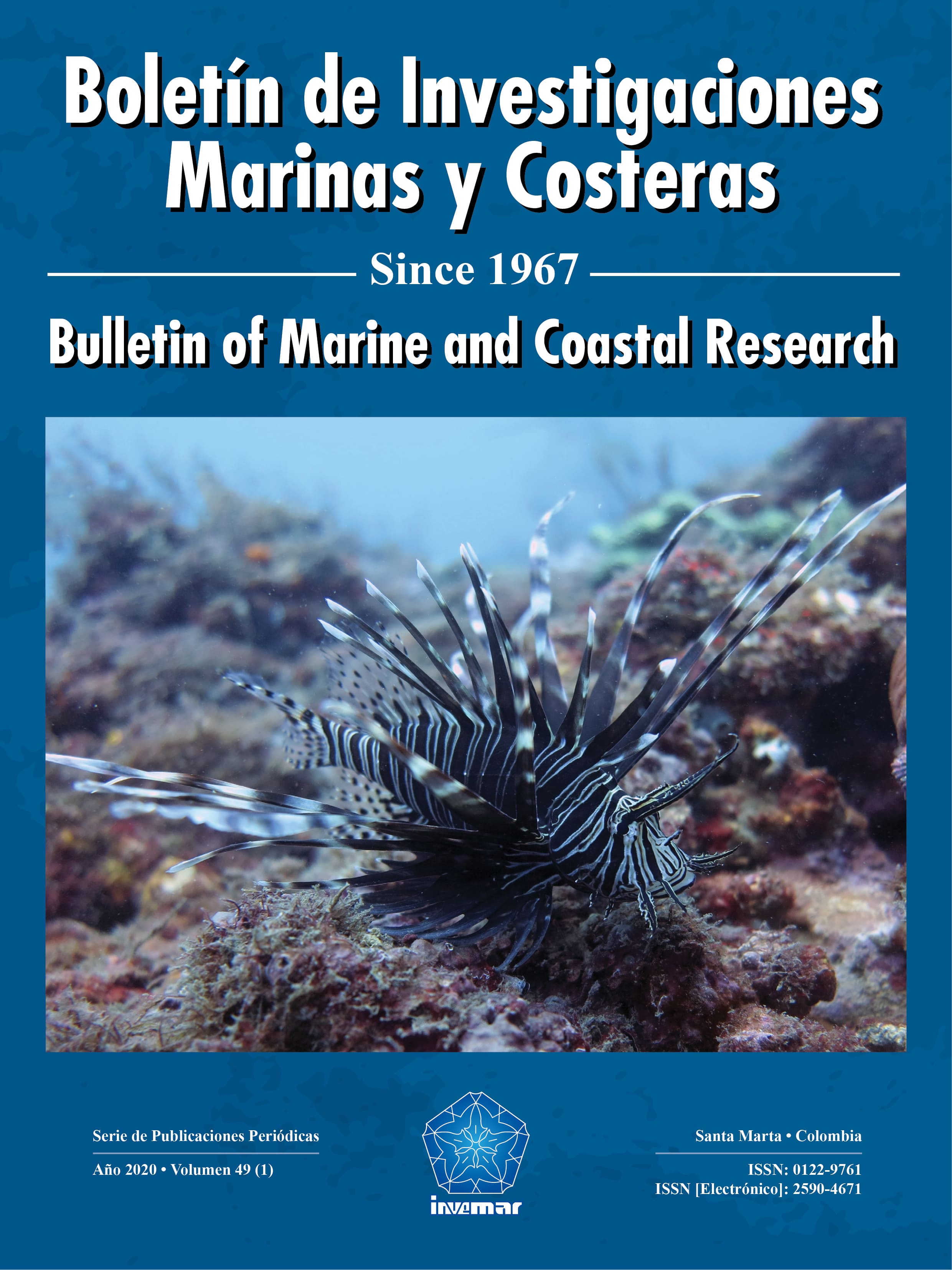Presence of Poecilia mexicana Steindachner in a temporary hyperhaline estuary of the Gulf of Mexico
DOI:
https://doi.org/10.25268/bimc.invemar.2020.49.1.772Keywords:
Laguna El Llano, Poeciliidae, Atlantic Topote, Veracruz.Abstract
In this contribution, Poecilia mexicana is recorded for the first time in a blind estuary study under hyperhalin conditions in the Gulf of Mexico and various ecological characteristics of the species are analyzed. 170 specimens in total (128 females and 42 males), were collected in May 2013 in the Laguna El Llano estuary, Veracruz, Mexico, which presented warm waters (31.4 °C), well-oxygenated (9.45 mg/L), transparent, and hyperhaline (average 73 UPS). Females were collected in a size range of 4.28-59.21 mm in standard length and 0.04-5.48 g by weight; males were collected in a size range of 15.73-51.41 mm LP and 0.091-2.97 g by weight. Largest size range was 10-29 mm standard length. The females presented a negative allometric growth; the males presented an isometric growth. Hyperhalinity of the water did not seem to affect the reproduction process of P. mexicana, since mature females were found with oocytes, eggs, and embryos, some of them presenting superfetation. Fertility was recorded between 12-179 oocytes/female, 8-162 eggs/female and 29-72 embryos/female. Condition factor was positively correlated with the standard length and weight. This species can be classified as a detritivorous consumer that supplements its diet with minimal proportions of diatoms.
References
Aguirre-León, A., H. E. Pérez-Ponce y S. Díaz-Ruiz. 2014. Heterogeneidad ambiental y su relación con la diversidad y abundancia de la comunidad de peces en un sistema costero del golfo de México. Rev. Biol. Trop., 62(1): 145-163.
Alcaraz, C. and E. García-Berthou. 2007. Life history variation of invasive mosquitofish (Gambusia holbrooki) along a salinity gradient. Biol. Conserv., 139: 83-92.
Álvarez, J. 1970. Peces mexicanos (claves). Instituto Nacional de Investigaciones Biológicas y Pesqueras, México. 166 p.
Bellinger, G.B. and D.C. Sigee. 2010. Freshwater algae. Identification and use as bioindicators. Oxford University Press. UK. 271 p.
Brito, A. C. 2012. A changing definition of estuary? Adjusting concepts to intermittently closed and open coastal systems. J. Ecosyst. Ecogr., 2(1): 1000e106. doi: 10.4172/2157-7625.1000e106
Castro-Aguirre, J.L. y C. Mora-Pérez. 1984. Relación de algunos parámetros hidrometeorológicos con la abundancia y distribución de peces en la Laguna de la Mancha, Veracruz. An. Esc. Nal. Cienc. Biol. Méx., 75: 657- 702.
Chávez-López, R., A. Rocha-Ramírez and H. Cortés-Garrido. 2015. Some ecology features of Poecilia mexicana Steindachner, 1863 (Osteichthyes: Poeciliidae) from Alvarado Lagoonal System, Veracruz, Mexico. Am. J. Life Sci., 3(2): 76-84.
De Vlaming, V., G. Grossman and F. Chapman.1982. On the use of the gonosomatic index. Comp. Biochem. Physiol., 73A: 31 -39.
García, E. 2004. Modificaciones al sistema de clasificación climática de Köppen. Universidad Nacional Autónoma de México, México. 91 p.
González, R. 2012. The physiology of hyper-salinity tolerance in teleost fish: a review. J. Comp. Physiol. B, 182: 321-329.
Hammer, Ø., D.A.T. Harpe and P.D. Ryan. 2001. PAST: Paleontological statistics software package for education and data analysis. Paleont. Electr., 4: 9.
Ito, T. 1959. The Venice system for the classification of marine waters according to salinity: Symposium on the classification of brackish waters, Venice, 8-14 April 1958. Jap. J. Limnol., 20(3): 119-120.
Laverty, G. and E. Skadhauge. 2015. Hypersaline environments: 85-106. En: Riesch, R., M. Tobler and M. Plath (Eds.). Extremophile fishes. Springer International Publishing, Switzerland. 325 p.
Le Cren, E. 1951. The length-weight relationship and seasonal cycle in gonad weight and condition in the perch (Perca fluviatilis). J. Anim. Ecol., 66: 1504-1512.
Martin, S.B., A.T. Hitch, K.M. Purcell, P.L. Klerks and P.L. Leberg. 2009. Life history variation along a salinity gradient in coastal marshes. Aq. Biol., 8: 15-28. doi: 10.3354/ab00203
Miller, R.R. 2009. Peces dulceacuícolas de México. Comisión Nacional para el Conocimiento y Uso de la Biodiversidad, Sociedad Ictiológica Mexicana A.C., El Colegio de la Frontera Sur y Consejo de los Peces del Desierto México-Estados Unidos. México. 559 p.
Miller, R.R. 1983. Checklist and key to the mollies of Mexico (Pisces: Poeciliidae: Poecilia, subgenus Mollienesia). Copeia, (3): 817-822. Stable URL: http://www.jstor.org/stable/1444354
Morán-Silva, A., L. Martínez-Flores, R. Chávez-López, F. Contreras, F. Gutiérrez, N. Brown-Peterson and M. Peterson. 2005. Seasonal and spatial patterns in salinity, nutrients, and chlorophyll-a in the Alvarado Lagoonal System, Veracruz, México. Gulf Carib. Res., 17: 133-143.
Needles, L.A., S.E. Lester, R. Ambrose, A. Andren, M. Connor, J. Eckman, B. Costa-Pierce, S.D. Gaines, M.S. Peterson, A. Scaroni, J. Weis and D.E. Wendt. 2015. Managing bay and estuarine ecosystems for multiple services. Estuar. Coast. 38(Suppl.1): S35-S48. doi: 10.1007/s12237-013-9602-7
Nordlie, F.G. 2006. Physicochemical environments and tolerances of cyprinodontoid fishes found in estuaries and salt marshes of eastern North America. Rev. Fish Biol. Fish., 16: 51-106.
Pope, K.L., S.E. Lochman and M.K. Young. 2010. Methods for assessing fish populations: 325-351. In: Quist, M.C. and W.A. Hubert (Eds.). Inland fisheries management in North America. American Fisheries Society, Maryland. 736 p.
Potter, I.C., B.M. Chuwena, S.D. Hoeksemaa and M. Elliott. 2010. The concept of an estuary: A definition that incorporates systems which can become closed to the ocean and hypersaline. Estuar. Coast. Shelf Sci., 87(3): 497-500.
Potter, I.C., J.R. Tweedley, M. Elliott and A.K. Whitfield. 2015. The ways in which fish use estuaries: a refinement and expansion of the guild approach. Fish Fish., 16(2): 230-239. http://onlinelibrary.wiley.com/doi/10.1111/faf.12050/full
Prescott, G.W. 1978. How to know the freshwater algae. W. C. Brown Co., Iowa. 293 p.
Ricker, W.E. 1975. Computation and interpretation of biological statistics of fish populations. Fisheries and Marine Service, Ottawa. 382 p.
Riesch, R., I. Schlupp, M. Tobler and M. Plath. 2006. Reduction of the association preference for conspecifics in cave-dwelling Atlantic mollies, Poecilia mexicana. Behav. Ecol. Sociobiol., 60(6): 794-802. doi:10.1007/s00265-006-0223-z.
Riesch, R., I. Schlupp, R.B. Langerhans and M. Plath. 2011. Shared and unique patterns of embryo development in extremophile poeciliids. PLoS ONE, 6(11): e27377. doi:10.1371/journal.pone.0027377
Rodríguez-Varela, A.C., A. Cruz-Gómez and H. Vázquez-López. 2010. List of ichthyofauna in the Sontecomapan lagoon, Veracruz, México. Biocyt, 3(9): 107-121.
Stearns, S.C. 1992. The evolution of life histories. Oxford University Press, Oxford. 249 p.
Tipsmark, C.K., K.J. Sørensen and S.S. Madsen. 2010. Aquaporin expression dynamics in osmoregulatory tissues of Atlantic salmon during smoltification and seawater acclimation. J. Exp. Biol., 213:368- 379.
Tobler, M. 2008. Divergence in trophic ecology characterizes colonization of extreme habitats. Biol. J. Linn. Soc., 95: 517-528.
Tobler, M. and M. Plath. 2011. Living in extreme environments: 120-127. In: Evans, J., A. Pilastro and I. Schlupp (Eds.): Ecology and evolution of poeciliid fishes. Chicago University Press, Chicago. 424 p.
Trujillo-Jiménez, P. y B.H. Toledo. 2007. Alimentación de los peces dulceacuícolas tropicales Heterandria bimaculata y Poecilia sphenops (Cyprinodontiformes: Poeciliidae). Rev. Biol. Trop., 55(2): 603-615.
Vazzoler, A. 1996. Biología da reproduçao da peixes teleosteos. EDUEM, São Paulo. 169 p.
Vega-Cendejas, M.E., M. Hernández de Santillana and S. Norris. 2013. Habitat characteristics and environmental parameters influencing fish assemblages of karstic pools in southern Mexico. Neotrop. Ichthyol., 11(4): 859-870.
Verkman, A.S. 2011. Aquaporins at a glance. J. Cell Sci., 124:2107-2112.
Whitfield, A.K. 2015. Why are there so few freshwater fish species in most estuaries? J. Fish Biol., 86: 1227-1250. doi:10.1111/jfb.12641.
Whittamore, J.M. 2012. Osmoregulation and epithelial water transport: lessons from the intestine of marine teleost fish. J. Comp. Physiol. B, 182: 1-39.


